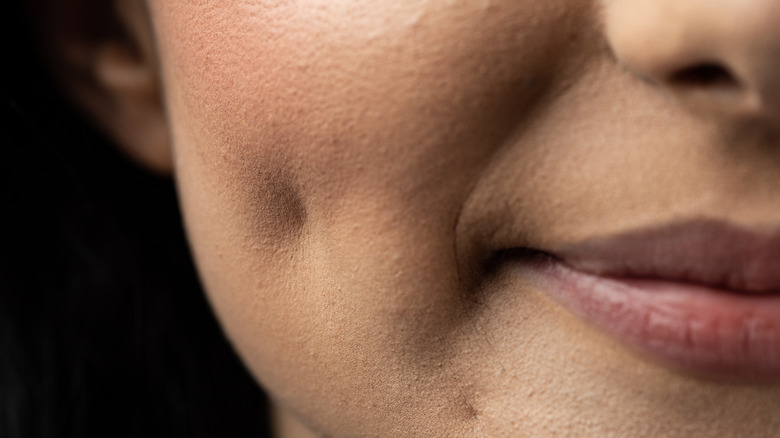Why Do Some People Have Dimples And Can You Get Them If You Don't?
If you haven't yet today, take a moment to look in the mirror and appreciate all your fascinating and beautiful features. Even though people come in a vast array of sizes, shapes, and colors, you are actually 99.9% genetically identical to every other human on this earth — it's that 0.1% of your genes that make you who you are (via the National Human Genome Research Institute). That tiny bit of genetic information determines everything from your skin tone to your hair texture, eye color, and even your earlobe shape. In fact, it's responsible for some of the rarest features among humans, including gray and green eyes, red hair, webbed digits, cleft chins, and dimples.
It's estimated that between 20% and 30% of people in the world have dimples (via MedicineNet). If you're one of the lucky few, you've probably wondered what causes those adorable, cheeky dents. Or if you don't have dimples, you might be curious about how to get them yourself. Although they're such a striking facial feature, few people know the truth about facial dimples and where they come from. We've got the answers to all your dimple dilemmas and more.
What are dimples?
Dimples are caused by a genetic difference in facial muscles below the skin, and they're technically considered an abnormality. While in the womb, some people develop shorter-than-average facial muscles, and the connective tissue in their cheeks fails to form "normally" around these short muscles (via Genetic). As a result, when these people smile, the gap between their facial muscles becomes more prominent, and cute little dimples are revealed!
The Genetic Science Learning Center at the University of Utah explains that dimples are a dominant trait, so if you have dimples, it's very likely that your biological children will too. However, dimpled parents don't guarantee dimpled babies; sometimes, these children are born without dimples, suggesting that the trait may be influenced by other factors too.
People can also have varying degrees of dimples. Some dimples are very deep and high-set, while others are more subtle and close to the mouth. Dimples can also form on the lower back, just above the tailbone. These back dimples are known as "dimples of Venus," and they're more common in female-born people (via Healthline). You can't get rid of dimples, but they may fade over time as your skin loses elasticity and they blend in with wrinkles.
Why are dimples considered cute?
How did a small abnormality become so desirable in our culture? Was there some evolutionary advantage that turned dimples into a dominant trait? Science says it mostly boils down to babies. Our brains are innately determined to love everything about babies' appearances, and babies have evolved over time to become even more appealing and adorable.
According to Science ABC, babies with "cuter" features make adults feel more empathetic and attached, suggesting that they may receive better care from their parents. Big eyes, chubby cheeks, soft bodies, and dimples are all part of an "evolutionary tactic" that babies use to get our attention and increase their odds of survival.
For many of the same reasons we're drawn to dimples on babies, we think they're an attractive feature in a potential adult mate. Dimples signal youthfulness, kindness, and a need to be loved and cared for. They are unique and memorable, and they make a person's facial expressions seem more dramatic. Although many cultures have appreciated dimples for centuries, they really came into the American spotlight thanks to the adorable dimple-faced child actress Shirley Temple, who starred in the movie "Dimples" in 1936.
Can you get dimples if you aren't born with them?
Dozens of beauty tools and tutorials out there claim that they'll give you dimples, but unfortunately, that's just not possible. Remember, dimples are hereditary, caused by short facial muscles, so no amount of poking, pushing, or massaging will give you the trait. However, if you're dying to have dimples, there are a few routes you can take to fake those cute little dents.
The most extreme but effective option is to undergo dimpleplasty. During a dimpleplasty procedure, a cosmetic surgeon will cut out a small amount of cheek muscle and fat, then suture the dimple into the gap they've just created. If there aren't any (unlikely) complications, a dimpleplasty can cost around $1,500 (via Healthline).
Of course, there are much safer ways to emulate the dimpled look. Cheek piercings are a trendy solution that lets you create the illusion of dimples using crystal studs or barbell jewelry. Once the piercing has healed, you can also take the jewelry out to reveal small dimple-like scars. If you're still saying "no, thank you" to needles and knives, makeup is a safe and temporary way to get the dimpled look. Simply draw on your cheeks with a dark eye pencil, blend with contour, and take some cute selfies!



